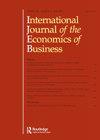Half-Century of Stagnation: Labor Productivity in Ontario’s Gold Mining Industry
IF 0.9
Q3 BUSINESS
International Journal of the Economics of Business
Pub Date : 2023-10-09
DOI:10.1080/13571516.2023.2260107
引用次数: 0
Abstract
AbstractThis paper explores labor productivity in Ontario’s gold mining industry from 1920 to 1970. The gold produced by a worker is nearly identical in 1920 and 1970, suggesting that the industry experiences no productivity gains over this period. Further, labor productivity in the intervening years was nearly 30% lower than these values, raising concerns about the ability of the industry to remain profitable given a fixed gold price. We look at over 180 different Ontario gold mines comprising nearly the entire industry to determine whether workers become less efficient over time, or whether other factors, such as entry and exit into the industry, declining ore quality, or changes in capital stock, are the primary drivers of this stagnation. This analysis considers the impact of events, such as a sudden 70% rise in the price of gold in 1934, World War II, and the post-war subsidization of the industry on productivity within the industry.Keywords: Productivitygold miningOntarioJEL CLASSIFICATION: D22D24L72N52Q3 Disclosure statementNo potential conflict of interest was reported by the author(s).Notes1 See Times (Citation1933).2 See Skogstad (Citation2021) for a detailed description of the gold mining subsidy.3 Huynh and Petrunia (Citation2016) and Petrunia (Citation2007) find that there is a long-term dynamic development process following a firm’s entry.4 Grade refers to the amount of gold present in a ton of ore.5 In 1951, the formula was given by the following:S=0.5 (C−22) (2)where S is the subsidy per ounce, and C is the actual average operating cost per ounce of gold. For example, a mine producing 20,000 ounces of gold, of which half is eligible for the subsidy, at an average cost of $28 per ounce receives a total subsidy of $30,000.6 Knox (Citation1955).7 Kerekes (Citation2011) provides a STATA program to implement the method on our data. Shannon and Moazzami (Citation2014) and Shannon and Moazzami (Citation2015) apply the method to estimate structural breaks in unemployment rates for OECD countries and Canadian provinces, respectively.8 Aydin and Tilton (Citation2000) and Garcia, Knights, and Tilton (Citation2001).半个世纪的停滞:安大略金矿行业的劳动生产率
摘要本文研究了1920 ~ 1970年安大略省黄金采矿业的劳动生产率。1920年和1970年,一名工人生产的黄金几乎相同,这表明该行业在此期间没有生产率提高。此外,在此期间的几年里,劳动生产率比这些价值低了近30%,这引发了人们对该行业在固定金价下保持盈利能力的担忧。我们研究了安大略省180多个不同的金矿,几乎涵盖了整个行业,以确定工人是否会随着时间的推移而效率降低,或者其他因素,如进入和退出行业、矿石质量下降或资本存量的变化,是否是这种停滞的主要驱动因素。这种分析考虑了一些事件的影响,比如1934年黄金价格突然上涨70%,第二次世界大战,以及战后对该行业生产率的补贴。关键词:生产力;金矿开采;安大略省jel分类:D22D24L72N52Q3披露声明作者未报告潜在利益冲突。注1参见Times (Citation1933)参见Skogstad (Citation2021)对金矿开采补贴的详细描述Huynh和Petrunia (Citation2016)和Petrunia (Citation2007)发现,企业进入后存在一个长期的动态发展过程品位是指每吨矿石中所含的黄金量。5 1951年,公式为:S=0.5 (C−22)(2),其中S为每盎司黄金的补贴,C为每盎司黄金的实际平均经营成本。例如,一个金矿生产20 000盎司黄金,其中一半有资格获得补贴,平均成本为每盎司28美元,总补贴为30 000 0.6诺克斯(引文1955)Kerekes (Citation2011)提供了一个STATA程序来在我们的数据上实现该方法。Shannon and Moazzami (Citation2014)和Shannon and Moazzami (Citation2015)分别运用该方法估算了经合组织国家和加拿大各省失业率的结构性断裂艾丁和蒂尔顿(Citation2000)和加西亚,骑士和蒂尔顿(Citation2001)。
本文章由计算机程序翻译,如有差异,请以英文原文为准。
求助全文
约1分钟内获得全文
求助全文
来源期刊
CiteScore
2.60
自引率
8.30%
发文量
9
期刊介绍:
International Journal of the Economics of Business presents original, peer reviewed research in economics that is clearly applicable to business or related public policy problems or issues. The term "business" is used in its widest sense to encompass both public and private sector—governmental, private non-profit and cooperative organizations, as well as profit-seeking enterprises. International Journal of the Economics of Business carries papers relating to three main spheres: The organization—to analyse and aid decision making and the internal organization of the business; The industry—to analyse how businesses interact and evolve within and across industries.

 求助内容:
求助内容: 应助结果提醒方式:
应助结果提醒方式:


